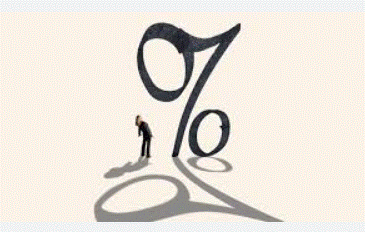 Overview: The market expects a soft US CPI print today, which has recently been associated with risk-on moves. The US 10-year yield is holding slightly above 3.50%, the lowest end of the range since the middle of last month. The two-year yield is a little above 4.20%, also the lower end of its recent range. Most observers see the Federal Reserve slowing the pace of its hikes to a quarter point on February 1. The dollar has spent the last few days consolidating after selling off last Friday and Monday. The caveat is that this would be the sixth consecutive month of slowing US CPI and many are positioned for it. This would seem to boost the risk of a counter-intuitive move on profit-taking after the news. It seems that everyone is on the same side of the trade now, and that often makes for treacherous activity.
Overview: The market expects a soft US CPI print today, which has recently been associated with risk-on moves. The US 10-year yield is holding slightly above 3.50%, the lowest end of the range since the middle of last month. The two-year yield is a little above 4.20%, also the lower end of its recent range. Most observers see the Federal Reserve slowing the pace of its hikes to a quarter point on February 1. The dollar has spent the last few days consolidating after selling off last Friday and Monday. The caveat is that this would be the sixth consecutive month of slowing US CPI and many are positioned for it. This would seem to boost the risk of a counter-intuitive move on profit-taking after the news. It seems that everyone is on the same side of the trade now, and that often makes for treacherous activity.
The yen is the strongest of the G10 currencies today, rising more than 1% on a news report warning that the BOJ could adjust its policies again as early as next week’s meeting. Market participants surprised by last month’s move do not want to be caught off guard again and the scar tissue makes them particularly sensitive to the press report. Sterling is the second-best performer so far today, up about 0.25%, despite disruptive rail strikes. Meanwhile, Chinese officials are not protesting hard the strength of the yuan, which is at its best level since last August. However, it is the Mexican peso, which is capturing the spotlight. It is trading at new highs since February 2020.
Asia Pacific
A report in Yomiuri, the Japanese newspaper, said that at next week’s BOJ meeting, officials will discuss the side effects of the extraordinary monetary policy and consider adjusting its bond purchases or other measures to counter the volatility spurred by last month’s moves. The yen, already bid, apparently on lower yields ahead of the US CPI rose to a new six-day high and JGBs fell even though the BOJ spent a record JPY2.8 trillion ($21.5 bln) to defend the 0.50% cap on the 10-year bond. Separately, Japan reported its November current account balance swung into surplus (JPY1.8 trillion) after recovered a small deficit in October. That puts its about 16% above last November’s surplus.
China’s producer prices fell 0.7% year-over-year last month. The median forecast in Bloomberg’s survey was for a 0.1% decline after -1.3% in November. The impact of the efforts to reanimate the property sector were blunted by the reversal of Covid policy. The pace of consumer inflation ticked to 1.8% from 1.6%, as expected. Rising vegetable prices seem understandable, but the rise in service prices and recreation prices seem less intuitive. Food prices rose by 4.8% after rising 3.7% in the 12-month through November. Non-food prices have been steadily rising at a 1.1% pace for the last three months of last year. Core CPI edged up to 0.7% from 0.6%.
Australia’s November trade surplus rose to A$13.2 bln from A$12.7 bln. Exports were flat and imports fell by 1%. It is the largest monthly trade surplus since June and raised the year’s monthly average to nearly A$11.6 bln. In the first 11 months of 2021, it averaged A$10.1 bln. And pre-Covid, in 2019, the average monthly surplus for the same period was almost A$5.6 bln.
The prospect of new action next week by the BOJ sent the dollar down from around JPY132.45 to nearly JPY130.85. Expectations for a soft US CPI (and lower US yields) contributed to greenback’s weakness. The dollar has stabilized around JPY131 in the European morning. Initial resistance is now seen near JPY131.50. Recall that the low set on January 3 was near JPY129.50. The Australian dollar continues to consolidate within the range set on Tuesday (~$0.6860-$0.6925) despite the higher-than-expected inflation, stronger retail sales, and today’s larger-than-expected trade surplus. That said, the consolidation pattern is usually seen as bullish. Monday’s high was $0.6950, which is now slightly above the upper Bollinger Band. With the greenback broadly weaker, it may not be surprising it fell to a new low since last August against the Chinese yuan near CNY6.7420. The PBOC does not appear to be resisting yuan strength very much. Again today, it set the dollar’s reference rate close to but lower than the median in Bloomberg’s survey (CNY6.7680 vs. CNY6.7686).
Europe
Europe is transforming before our eyes. Russia’s invasion of Ukraine has succeeded to accomplish what no US president has managed to achieve. Get Europe, and especially Germany to boost is defense spending, and dramatically reduce its reliance on Russian oil and gas. In addition to bringing Europe in closer alignment with US strategic aims, America also gains commercially. The weapons bought will favor American arms producers. America’s natural gas will replace a significant part of Russian supplies. Yet the relationship is more nuanced that many pundits who seemingly seek social media-sized phraseology would seem to allow. Reports suggest the German government is set propose at next month’s EU summit a new joint financing instrument help its member compete with the US $370 bln nationalistic green subsidy initiative. It sees the European Investment Bank as the key institution for this and wants to reallocate unused funds from the pandemic recovery fund to bolster green energy investment. In addition, Germany may propose reforming existing state aid rules to allow an increase of national subsidies for green energy. It is partly premised on the idea that the US will not meaningfully change its new plans, for which the EU retains the right to challenge at the WTO.
It has been more than 55 years since Jean Servan-Schreiber’s best-seller (The American Challenge), accused US companies using direct investment (buying and building production facilities in Europe) of colonizing Europe, during the heart of the Cold War (with the Soviet Union).There are clear competitive and cooperative elements in the relationship. The Scholz government in Berlin also seeks deeper trade relations with the US. It is sympathetic to using the EU-US trade and technology forum to lower or abolish tariffs and is favorably disposed to a free-trade agreement which has proved elusive for a generation. At the same time, it seems to recognize that a “Buy Europe” initiative could help encourage the US to also reconsider an FTA with the EU.
The euro is firm after making edging up to new seven-month high yesterday around $1.0775. It is trading within yesterday’s half cent range (~$1.0725-$1.0750). Nearby resistance is seen at $1.08. It has not traded below $1.07 since Monday. Separately, we note that strong euro buying yesterday lifted it above parity against the Swiss franc for the first time since last July and above the 200-day moving average for the first time since last June. There is some talk that the Swiss franc has replaced the yen in cross positions against the euro. The next technical target may be near CHF1.01. Sterling, too, has spent the last few days consolidating last Friday and this Monday’s advance that took from about $1.1840 to $1.2210. The narrow sideways trading is often associated with a bullish technical pattern. Recall that the $1.2215 area corresponds to the (61.8%) retracement of the sterling’s losses since peaking near $1.2450 in mid-December. A break above there would target that high again.
America
The US December CPI is center stage, and ahead of it already one regional Fed president (Boston’s Collins, a non-voter this year at FOMC meetings) endorsed a quarter-hike, while others have that have spoken have kept the door open to a 50 bp move. The market (median forecast in Bloomberg’s survey) looks for the first monthly decline in CPI since May 2020. It is owing to the decline in energy prices. Still, look at the quarterly figures annualized. In Q1 22 and Q2 22, as the US economy was contracted, CPI was rising at a 10%+ annualized clip. It slowed to a little more than 2% in Q3, and if the median forecast is correct, the annualized pace in Q4 will be about 1.6%. The core rate, as widely recognized, is stickier. At an annualized pace it rose by about 5.6% in Q1 22 and 8.4% in Q2 22. It slowed to 6% in Q3, and if the median forecast for a monthly gain of 0.3% in December proves accurate, it would translate into an annualized pace of slightly more than 3.2%. Headline inflation peaked on a year-over-year basis at 9.1% in and has slowed every month since. The 6.5% median forecast for December would be the slowest since October 2021. The core rate peaked at 6.6% in September and the median forecast of 5.7% would the slowest last year. Moreover, it is also widely understood that the inputs for the calculation of shelter costs have a longer lag time and that shelter costs, a key component to the core rate, will ease later this year.
Without intending to rehash the temporary vs. structural debate about inflation, the fact of the matter is that the world was hit with a number of shocks and as these shocks dissipate, price pressures are generally easing. There are, of course, exceptions, like Japan, and Australia’s where the new monthly inflation measure reached new cyclical highs. There is a concern that the “end of globalization,” which still has to be proven, will boost prices. Yet, a more likely scenario seems to be that the reshoring or near-shoring of manufacturing capacity take places with technological advances that further reduces the labor component. This means manufacturing output may increase without a rise in labor costs, which for the most part are a small part of the cost of manufactured goods in the first place. A recent meme in the social media is that inflation is a distribution issue and not simply a question of volumes, prices, and velocity of money. Like “polycrisis” this is a rediscovery of what some have long recognized. Just like most crises are not limited to one dimension, as if the economy is somehow separate from society, there has long been a view of the “political nature of inflation. A little more than 40 years ago, for example, economic professors, Bowles, Gordon, and Weisskopf penned Beyond the Wasteland: A Democratic Alternative to Economic Decline, which argued that US inflation was the economic outcome of political processes.
The US dollar continues to trade within Monday’s range against the Canadian dollar (~CAD1.3355-CAD1.3465). It held above CAD1.34 yesterday and so far, today. A soft US inflation print has been recently associated with strong equity market advances, and the Canadian dollar seems particularly sensitive. The Mexican peso surged yesterday to its best level since February 2020. The greenback was sold through MXN19.00 and edged down further today nearly MXN18.90. The combination of high rates, relatively low currency volatility, and political stability (relative to other Latam countries) underpins its attractiveness in carry strategies. Recall it was trading near MXN18.55 before the Covid shock. The lower Bollinger Band is found near MXN18.90 today.
Full story here Are you the author? Previous post See more for Next postTags: #USD,Australia,China,Currency Movement,Europe,Featured,inflation,Japan,Mexico,newsletter


















